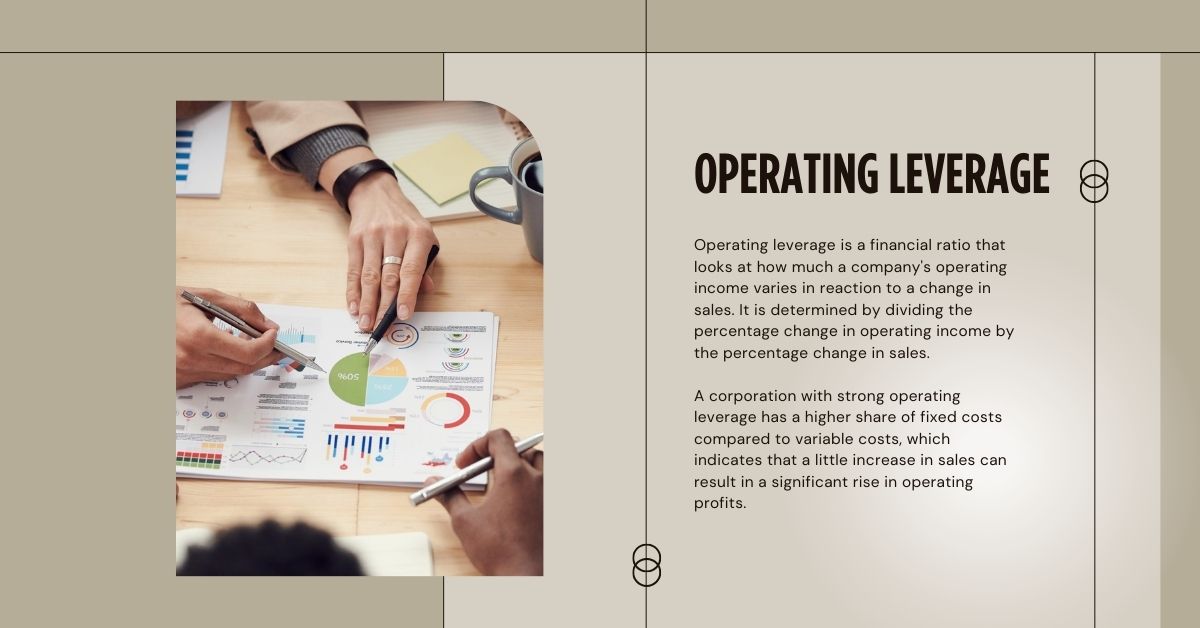Understanding a company’s cost structures can help you make critical financial decisions, regardless of whether you work in finance or accounting. Operating leverage is one way to examine a company’s costs.
In this post, we explain what operating leverage is, who might use it, and why, as well as show two methods for calculating operating leverage using examples.
What is Operating Leverage?

Operating leverage is a financial ratio that looks at how much a company’s operating income varies in reaction to a change in sales. It is determined by dividing the percentage change in operating income by the percentage change in sales. A corporation with strong operating leverage has a higher share of fixed costs compared to variable costs, which indicates that a little increase in sales can result in a significant rise in operating profits.
However, a company with low operating leverage has a high proportion of variable costs relative to fixed costs, implying that a minor rise in sales will not result in a significant gain in operating income.
Formula of Operating Leverage
The formula for calculating operating leverage is:
Operating Leverage = Contribution Margin/Operating Income
Here:
- The contribution margin is the difference between sales revenue and variable costs. It denotes the amount of money available to pay fixed costs and make a profit.
- Operating income is the profit a company makes before interest and taxes. It is often referred to as EBIT (earnings before interest and taxes).
Operating leverage is a measure of how sensitive a company’s operating income is to changes in sales. A higher operating leverage indicates that a minor change in sales can result in a significant change in operating income, either positive or negative.
Example of Operating Leverage
Consider two companies, Company A and Company B, both selling the same product. Company A has a high proportion of fixed costs (such as rent for a large factory and expensive machinery), whereas Company B has a high proportion of variable costs (such as raw materials that fluctuate in price).
Scenario 1: Increase in sales
- If both companies raise their sales by 10%, Company A with high operating leverage will most likely see a far higher rise in operating income since its fixed costs are spread across a larger number of units.
- Company B, which has minimal operating leverage, will see a more moderate growth in operating income since its variable costs will rise proportionally to sales.
Scenario 2: Decreased Sales
- If both companies’ sales fall by 10%, Company A’s operating income will most certainly fall considerably more because its fixed costs remain largely constant even with lower sales volume.
- Company B, with minimal operating leverage, will experience a more moderate decline in operating income as variable expenses fall in tandem with sales.
In conclusion, Company A with significant operating leverage is more susceptible to variations in sales volume. A little change in sales might cause a significant change in operating income, either positive or negative.
Why is the Operating Leverage Equation Important?
The operating leverage equation plays a role because it gives useful information about a company’s financial risk and profitability. It helps to understand how a company’s operational income reacts to changes in sales volume. A high operating leverage indicates that a minor change in sales can result in a significant change in operating income, whether positive or negative.
This can be advantageous during moments of expansion, but it can also be harmful during economic downturns. However, a low operating leverage means that changes in sales volume have a smaller influence on operating income. Understanding a company’s operating leverage allows investors and management to make better decisions regarding its financial health and risk profile.
Benefits and Risk of Using Operating Leverage
| Benefit | Risk |
|---|---|
| Amplified Profit Growth: During periods of growth, high operating leverage can lead to significant increases in operating income, boosting profitability. | Increased Financial Risk: High operating leverage can make a company more vulnerable to economic downturns or decreased sales, as fixed costs remain relatively constant even when sales decline. |
| Improved Efficiency: High operating leverage can encourage companies to operate at higher capacity levels, leading to improved efficiency and lower unit costs. | Higher Break-Even Point: Companies with high operating leverage have a higher break-even point, meaning they need to sell more units to cover their fixed costs and start generating profits. |
| Reduced Variable Costs: High operating leverage can help companies reduce their variable costs per unit, as fixed costs are spread over a larger number of units. | Increased Sensitivity to Price Changes: Companies with high operating leverage are more sensitive to changes in product prices, as small changes can have a significant impact on profitability. |
Is High Operating Leverage Good?
Whether strong operating leverage is helpful or harmful depends on the individual conditions of a company and the economic climate.
In times of expansion, significant operating leverage can be beneficial because it can boost profit growth. This is because even a minor increase in sales can result in a significant rise in operating profits. However, a minor fall in sales can result in a significant decrease in operating income.
High operating leverage can be problematic during economic downturns or sales declines. Companies with high operating leverage may struggle to cover fixed costs, resulting in losses.
Finally, the decision to have high or low operating leverage is strategic. When making this decision, companies must take into account their industry, market conditions, and risk tolerance.
Want to know more about other leverage? You can also read this article:
Can Operating Leverage Be 1?
Yes, operating leverage can equal 1. An operating leverage of one means that a company’s operating income varies in direct proportion to its sales. This means that every 1% change in sales will result in a 1% change in operating income.
This condition is uncommon because most businesses have some level of fixed costs, resulting in an operational leverage greater than 1. However, in certain cases, such as a company with extremely low fixed costs or one where variable expenses account for a considerable fraction of overall expenditures, operating leverage may be close to or equal to one.
Can a Company Have Negative Operating Leverage?
No, a corporation can’t have negative operating leverage.
Operating leverage measures how sensitive a company’s operating profitability is to variations in sales volume. It is determined by dividing the percentage change in operating income by the percentage change in sales. Because both operating income and sales cannot be negative, the percentage change ratio cannot be negative.
If a company’s operating income falls at a slower rate than its sales, it indicates that it has low operating leverage, but it is not negative.
What Is the Degree of Operating Leverage (DOL)?
The Degree of Operating Leverage (DOL) is a financial measurement that assesses the sensitivity of a company’s operating profitability to changes in sales revenue. It calculates how much a company’s operational income will vary with a percentage change in sales.
A greater DOL shows that a corporation has a higher share of fixed costs vs variable expenses. This indicates that a minor change in sales can result in a significant change in operating income, whether positive or negative. As a result, a lower DOL signifies a lower amount of fixed expenses, making the company less subject to swings in revenue.

